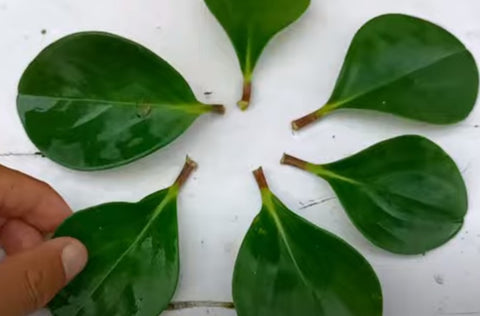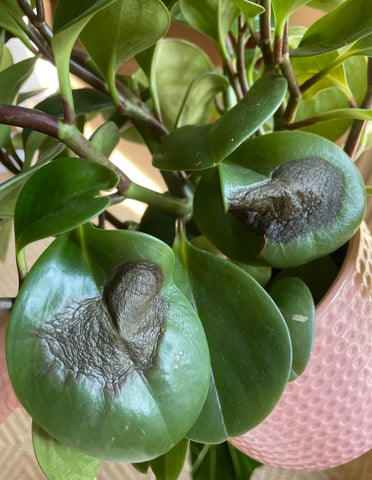Baby Rubber Plant Care, Propagation & Solutions to Common Issues
The Baby Rubber Plant is a gorgeous tropical plant, known for its fleshy, waxy leaves, which grow from short stems. It’s a popular houseplant because of its easy-care needs. That makes it the perfect beginner-friendly green companion.
This plant likes moderate humidity and moderate warmth and needs a drink every week or so, depending on its growing conditions. Besides, propagating more plants from an existing baby rubber plant is rather easy!
This comprehensive guide will help you learn how to care for a baby rubber plant, from meeting its growing needs to propagating it and preventing some common leaf issues. So, keep on reading.
About Baby Rubber Plants

The baby rubber plant, or Peperomia obtusifolia, is native to the West Indies, South America, and Mexico. This member of the Peperomia family has succulent-like characteristics, with thick and shiny leaves that store water.
It’s a relatively small plant, perfect for work desks, shelves, and hanging baskets. It's a beautiful, low-maintenance plant that can live up to 5-6 years indoors.
Peperomia obtusifolia is quite resilient to pests and diseases, making it reasonably hardy. No wonder it has earned its popularity among plant lovers.
How Do You Identify Peperomia Obtusifolia?
You can easily identify a baby rubber plant by its physical characteristics. It has plump and glossy leaves, much like succulents. They’re spoon-shaped and around 1”-2” long.
Peperomia obtusifolia plants come in many varieties. For instance, there’s the non-variegated baby rubber plant with plain and dark green leaves, while the variegated Baby Rubber plant varieties, including the Marble Peperomia, boast pale-green foliage with white specks and stripes.
An interesting variegated variety is the Lemon Lime, with leaves combining dark and light shades of green. Another stunning beauty is the Red Margin, known for the dark red tint along the leaf edges.
Peperomia obtusifolia variegata care is as simple as caring for any other variant of this plant. These indoor plants grow slowly and can reach up to 20”.
Peperomia Obtusifolia: Benefits
A baby rubber plant comes with the following set of attractive benefits:
- The Baby Rubber plant improves mental health. It regulates positive energy flow and reduces stress.
- This pet-friendly plant is an excellent choice for a household with curious pets and kids.
- It improves indoor air quality, due to its strong air-purifying properties. According to research, this plant is particularly great for properties with poor ventilation.
- With rounded leaves resembling coins, it is believed to bring luck and wealth. It’s also a great gift that conveys a message of reassurance.
- It’s small, lush, and beautiful - an excellent addition to any indoor space. It can transform an office space or jazz up your balcony or patio garden.
How to Care for a Baby Rubber Plant

Peperomia obtusifolia care is as simple as it gets, which is one of the best things about the plant. A little bit of TLC can make this plant flourish, even if you’re not a seasoned gardener.
Baby Rubber Plant: Watering and Light Requirements
The Peperomia obtusifolia plant is not demanding and does not require a lot of attention when it comes to its watering and light needs.
How Often Should I Water My Baby Rubber Plant?
As it can retain water in the leaves, the baby rubber plant doesn't demand frequent watering. It’s slightly drought-tolerant, and you can water it every 7-10 days. Check the soil and ensure that the top 2" are completely dry before you water it again
Do Baby Rubber Plants Need a Lot of Light?
The Baby Rubber Plant needs indirect light, like other Peperomia varieties. It can survive in low light, though medium bright light is recommended. Place it in a spot with partial shade or on a windowsill facing the west or east where it'll receive soft morning or late afternoon sunlight. Excess sunlight can scorch your Peperomia plant.
Baby Rubber Plant: Soil & Fertilizer
If you want your baby rubber plant to be healthy, pay attention to its soil and fertilization needs. Ensure that it gets sufficient nutrients to grow and flourish.
What Kind of Soil Does Peperomia Obtusifolia Like?
The Peperomia obtusifolia prefers light, slightly acidic, well-draining, and organically rich soil. An orchid potting medium is a great choice, though you can also use regular potting soil with an equal mix of peat moss and perlite, or coarse sand.
Do Baby Rubber Plants Need Fertilizer?
Baby rubber plants are low feeders. So, fertilizing them too often can cause nutrient toxicity, harming the short roots. Restrict the fertilization sessions to 3 times a year in the spring, summer, and fall. Allow your plant to rest during winter. Use a 10-10-10 water-soluble fertilizer.
How Often Should I Repot a Baby Rubber Plant?

When you first bring home a new baby rubber plant, wait 6-12 months before repotting it. After that, you can replant it once every two years.
It's best to transplant the plant during spring. It has a slow growth rate and doesn’t mind being slightly root-bound and snug in its pot, so it doesn't require frequent repotting.
However, move it to a larger pot when the roots poke out of the drainage holes. It indicates that the roots don't have sufficient space to grow.
A planter 2” larger than the current one should be sufficient. An excessively large container will keep the soil wet for too long, causing root rot. Also, remember to remove dead or rotting roots before transplanting your baby rubber plant in fresh soil. Water the soil thoroughly, but don’t make it soggy.
Baby Rubber Plant: Temperature and Humidity
The baby rubber plant enjoys moderately warm regions and medium humidity. It thrives in hardiness zones 10-12.
What Temperature Do Baby Rubber Plants Like?
The baby rubber plant is comfortable in a temperature range of 60°F-75°F. That means it will be happy in the standard indoor temperature in a US home or office. It doesn’t handle cold well and mustn't be exposed to temperatures below 55°F.
Do Baby Rubber Plants Like to Be Misted?
Baby rubber plants love to be misted regularly, especially in dry spells of weather. This keeps their surroundings warm and humid. It’s best to grow this plant where the humidity level is 40%-50%.
Baby Rubber Plant: Pruning
As mentioned, Peperomia obtusifolia plants have a slow growth rate. Still, pruning them will help you maintain their shape, appearance, and health. It’s best to prune the plant during the growth seasons, in spring and summer.
Should I Prune My Baby Rubber Plant?
You should prune your Peperomia to remove any discolored or damaged leaves. A good time to trim the baby rubber plant is when you water it. Use the opportunity to give it a better shape and bushier appearance.
How Do You Shape a Baby Rubber Plant?
Pruning is a good way to give your baby rubber plant a fuller look, but only if you do it right. Cut the leaves above the nodes (the point from where leaves grow) to encourage branching. This will control the overall shape of your plant’s foliage.
Peperomia Obtusifolia: Propagation Techniques

Propagation helps multiply your baby rubber plant collection. You can propagate your Peperomia obtusifolia from stem or leaf cuttings in both soil and water.
Where Do You Cut a Baby Rubber Plant to Propagate?
If you want to use a stem cutting for baby rubber plant propagation, pick a 4”-6” long stem with at least 3 leaves and cut below the node. Remove the bottom leaves if needed. For leaf propagation, pick a healthy leaf and cut it along with the petiole above the node.
How to Propagate a Baby Rubber Plant
To propagate baby rubber plants in soil, you can use a stem or leaf cutting. Let the cut end heal before dipping it in rooting hormone powder. Then, insert the cutting in the potting mix, pressing the soil around it. Water the stem or leaf cuttings and cover them with transparent plastic to create the right humid conditions
To propagate your Peperomia plant in water, you’ll need a stem cutting. Once its cut end heals, put it in a jar with filtered water and allow the roots to develop. Make sure to change the water every week. Once the roots grow, wait for a few weeks before moving your young plants to a pot with soil.
Common Baby Rubber Plant Leaf Issues

Even when you know how to take care of a baby rubber plant, you may sometimes spot some common leaf problems. You need to identify the causes to fix the issues.
Here’s a list of common baby rubber plant problems that you can prevent from happening to your beloved plant:
- Yellowing leaves: This often indicates overwatering. Remove these leaves and let the top soil layers dry out between watering sessions.
- Brown leaves: Browning blades or dark spots signal sunburn or underwatering. Move the plant to indirect light and check if the soil becomes too dry and needs more water. Overfertilization also results in leaf burn.
- Curling leaves: It suggests overwatering or underwatering. Check if the soil is too dry or wet between water sessions. Adjust your watering schedule accordingly.
- Leaves dropping: This might be caused by overwatering, extreme temperature changes, or transplant shock. Avoid sudden or frequent changes to your baby rubber plant’s environment.
- Insects: Mealybugs and spider mites may attack your Peperomia plant and you can remove them with insecticidal soap, or neem oil. Always isolate infested plants to prevent the problem from spreading to other plants.
Baby Rubber Plant Care: FAQs
Q: What does a healthy baby rubber plant look like?
A: A healthy baby rubber plant has vibrant, plump leaves that are spoon-shaped. These are glossy and dark green, though you’ll find variants with white or light green variegation or red edges. The stems of a healthy plant are thick and remain upright.
Q: Where do you put baby rubber plants?
A: You can put baby rubber plants in indoor spots with low to medium bright, indirect sunlight. East- or west-facing windows offer the right type of soft light your plant loves.
Q: Can baby rubber plants go outside?
A: Baby rubber plants can be placed outdoors as long as they are kept away from direct, scorching sunlight. A shaded location is recommended for this plant. It grows well outdoors in hardiness zones 10, 11, and 12.
Q: Do baby rubber plants flower?
A: The Peperomia obtusifolia is a flowering plant, but it only blooms occasionally. The flowers are creamy-white and appear in the form of slender spikes. They are not particularly showy.
Q: What is the difference between Peperomia obtusifolia and clusiifolia?
A: Peperomia obtusifolia has an upright growth, while Peperomia clusiifolia is bushier. The latter’s leaves are larger and more elongated, as seen in Peperomia Ginny. However, Watermelon Peperomia leaves are more rounded and have distinct streaks.
Conclusion
Caring for your Baby Rubber plant won’t take up much of your time and energy. Once you learn how to care for a Peperomia obtusifolia, you may feel excited to add more to your collection.
You can propagate the plant easily or add other Peperomia varieties to your green corner. Peperomia Frost, Caperata Rosso, Green Bean, or Santorini can all be great companions for your Baby Rubber plant.












Leave a comment